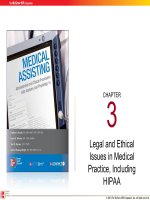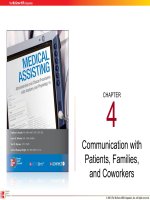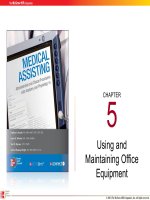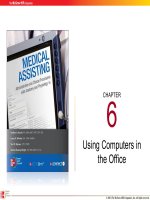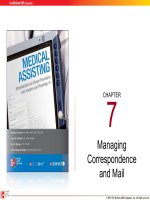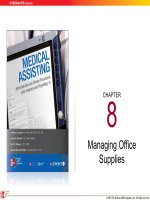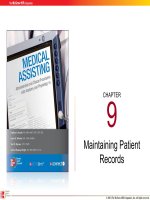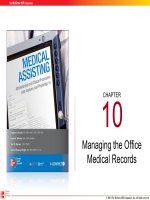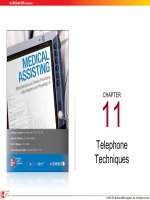Lecture Medical assisting: Administrative and clinical procedures with anatomy and physiology (4e) – Chapter 35
Bạn đang xem bản rút gọn của tài liệu. Xem và tải ngay bản đầy đủ của tài liệu tại đây (863.34 KB, 37 trang )
CHAPTER
16
Medical Coding
© 2011 T he McGraw -Hill Com panie s, Inc. A ll rights reserv ed.
16-2
Learning Outcomes
16.1 Explain the purpose and format of the ICD-9CM volumes that are used by medical offices.
16.2 Describe how to analyze diagnoses and
locate correct codes using the ICD-9-CM.
16.3 Identify the purpose and format of the CPT.
16.4 Name three key factors that determine the
level of Evaluation and Management codes
that are selected.
© 2011 T he McGraw -Hill Com panie s, Inc. A ll rights reserv ed.
16-3
Learning Outcomes (cont.)
16.5 Identify the two types of codes in the Health
Care Common Procedure Coding System
(HCPCS).
16.6 Describe the process used to locate correct
procedure codes using CPT.
16.7 Explain how medical coding affects the
payment process.
16.8 Define fraud and provide examples of
fraudulent billing and coding.
© 2011 T he McGraw -Hill Com panie s, Inc. A ll rights reserv ed.
16-4
Introduction
• Medical coding
– Translation of medical terms for diagnoses
and procedures into code numbers from
standardized code sets
– Tells payers that the services provided
• Were medically necessary
• Complied with payer’s rules
• Accurate claims bring maximum appropriate
reimbursement for the medical office
© 2011 T he McGraw -Hill Com panie s, Inc. A ll rights reserv ed.
16-5
Diagnosis Codes: The ICD-9-CM
Patient
Chief
Complaint
Physician
Medical
Diagnosis
Insurance
Diagnosis
Code
The diagnosis codes are found in the International Classification of
Diseases, Ninth Revision, Clinical Modification (ICD-9)
The use of ICD-9 codes in health care is mandated
by HIPAA for reporting:
Patient’s diseases
Conditions
Signs and symptoms
© 2011 T he McGraw -Hill Com panie s, Inc. A ll rights reserv ed.
16-6
The
ICD-9-CM
•
Alphabetic Index (Volume 2)
– Diagnoses appear in alphabetical order
– The index is organized by condition
– Use initially to look up conditions
– Cross-references
• Look up term that follows “see”
The Alphabetical Index is never used alone to find a diagnosis
code because it does not contain all the necessary information.
© 2011 T he McGraw -Hill Com panie s, Inc. A ll rights reserv ed.
16-7
The ICD-9-CM (cont.)
• Tabular List (Volume 1)
– Diagnoses appear in numerical order
– Listing is organized according to source or
body system
Code Structure
Codes are made up of three, four, and five digits and a description
Three-digit categories are used for diseases, injuries, and
symptoms
Categories are further divided into four- and five-digit codes
© 2011 T he McGraw -Hill Com panie s, Inc. A ll rights reserv ed.
16-8
The ICD-9-CM (cont.)
V Codes
• Supplementary classification of factors
influencing health status and contact with
health services
• Identify encounters for reasons other than
illness or injury
• May be a primary code or additional code
E Codes
• “E” – external
• Identify external causes of injuries and
poisoning resulting from environmental events
• Never used alone as a diagnostic code
© 2011 T he McGraw -Hill Com panie s, Inc. A ll rights reserv ed.
16-9
ICD-9-CM Conventions
A list of abbreviations, punctuation, symbols, typefaces, and notes
that provide guidelines for using the code set.
Conventions
[]
NOS
NEC
( )
Brackets are used around synonyms,
alternate wording, or explanations
An abbreviation that means “not
otherwise specified” or “unspecified”
An abbreviation that means “not
elsewhere classified”; used when the
ICD-9 does not provide a specific code
to describe the patient’s condition
Parentheses are used around
alternative wording
© 2011 T he McGraw -Hill Com panie s, Inc. A ll rights reserv ed.
16-10
ICD-9-CM Conventions (cont.)
Conventions
§}:
Excludes
Includes
Used
in
the
Tabular
Listis
Indicates
that
the
footnote
Indicates
that
the
entry
Brace
encloses
aofseries
Refines
content
after
an incomplete
is
toasall
notapplicable
classified
partterm
of the
of
preceding
terms
entry
subdivisions
in that code
preceding code
© 2011 T he McGraw -Hill Com panie s, Inc. A ll rights reserv ed.
16-11
ICD-9-CM Conventions (cont.)
Conventions
Code
Usefirst
Excludes
underlying
additional
disease
code
These
notes that
indicate
that an
This
means
the
code
is
This note means an
entry
isbenot
classified
as part
not
to
used
for
the
additional code should
of
the preceding code
primary
be used ifdiagnosis
available
© 2011 T he McGraw -Hill Com panie s, Inc. A ll rights reserv ed.
16-12
The ICD-9-CM Codes (cont.)
Record the code
on the claim form
Read all information to find
the code that corresponds to
the patient’s condition
Locate the code from the Alphabetic
Index in the Tabular List
Find the diagnosis in the Alphabetic Index
Locate the patient’s diagnosis
© 2011 T he McGraw -Hill Com panie s, Inc. A ll rights reserv ed.
16-13
The ICD-10-CM/ICD-10-PCS
• Revisions to ICD-9-CM
– ICD-10-CM – over 68,000 diagnostic codes
– ICD-10-PCS – 87,000 procedure codes
• Features
– Combination codes
– Codes for laterality
– Expanded codes capture more detail
– Flexibility and expandability
© 2011 T he McGraw -Hill Com panie s, Inc. A ll rights reserv ed.
16-14
Apply Your Knowledge
A medical assistant has looked up a medical term
in the alphabetic index, and next to the term is the
word “see.” What does this mean?
ANSWER: This means the medical assistant must look
up the term that follows the word “see” because
another category should be used or cross-referenced.
© 2011 T he McGraw -Hill Com panie s, Inc. A ll rights reserv ed.
16-15
Procedure Codes: The CPT
• Current Procedural Terminology (CPT) book
– The most commonly used system for reporting
procedures and services provided to the patient
• This is the HIPAA-required code set
• Published annually by the American Medical
Association (AMA)
– Updated annually
– Use the appropriate CPT book for the current year
© 2011 T he McGraw -Hill Com panie s, Inc. A ll rights reserv ed.
16-16
Organization of the CPT Manual
Except for the first section, the CPT book is arranged in
numerical order
Section
Evaluation and Management
Anesthesiology
Surgery
Radiology
Pathology and Laboratory
Medicine
Range of Codes
99201–99499
00100–01999
10021–69990
70010–79999
80048–89356
90281–99602
© 2011 T he McGraw -Hill Com panie s, Inc. A ll rights reserv ed.
16-17
Organization of the CPT Manual
(cont.)
• Add-on codes
– A plus sign (+) is used to indicate add-on
codes
– Always used with primary code
• Modifiers
– One or more two-digit numbers (up to three
per procedure) assigned to five-digit main
number
– Indicate that special circumstance applies
© 2011 T he McGraw -Hill Com panie s, Inc. A ll rights reserv ed.
16-18
Organization of the CPT Manual (cont.)
• Category II, III, and Unlisted procedure codes
– Category II – tracks health-care performance
measures
– Category III – temporary codes for emerging
technologies, services, and procedures
– Unlisted codes – used when no other code is
available
© 2011 T he McGraw -Hill Com panie s, Inc. A ll rights reserv ed.
16-19
Evaluation and Management (E/M) Codes
• Used by all physicians in any medical specialty
• Key factors that help determine level of service
The extent of the patient history taken
The extent of the examination conducted
The complexity of the medical decision made
New Patient versus Established Patient
New patients – not seen by physician within the past 3 years
Established patients – seen within a 3-year period
© 2011 T he McGraw -Hill Com panie s, Inc. A ll rights reserv ed.
16-20
Surgical Procedure Codes
• The surgical package
– All procedures normally a part of an operation
• Anesthesia
• Surgery
• Routine follow-up care
• Global period
– The time period covered for follow-up care
– If past global period, additional services are
reported separately
© 2011 T he McGraw -Hill Com panie s, Inc. A ll rights reserv ed.
16-21
The CPT (cont.)
Laboratory Procedures
• Panels – organ or disease-oriented
– Pathology and Laboratory sections
of the CPT
– If separate codes are used, they will
be rebundled and payment delayed
Immunizations
• Injections require two codes
– One for the procedure (injection)
– One for the medication (vaccine or toxoid)
© 2011 T he McGraw -Hill Com panie s, Inc. A ll rights reserv ed.
16-22
Apply Your Knowledge
1. Which section of the CPT is not arranged in
numerical order and why?
ANSWER: The first section, Evaluation and
Management, is not in numerical order because the
items in this section are used most often and by all
physicians in any medical specialty.
Excellent!
© 2011 T he McGraw -Hill Com panie s, Inc. A ll rights reserv ed.
16-23
Apply Your Knowledge
2. The insurance representative has questioned the
codes listed on three patient forms that were
submitted last year. When re-checking these forms
the office medical assistant should:
Excellent!
ANSWER:
a. Use the current book to validate accuracy of the codes
b. Use last year’s book to validate accuracy of the codes
c. Use next year’s book to validate accuracy of the codes
© 2011 T he McGraw -Hill Com panie s, Inc. A ll rights reserv ed.
16-24
HCPCS
• The Health Care Common Procedure Coding
System
– Developed by the Centers for Medicare and
Medicaid Services (CMS)
– Pronounced “hic-picks”
© 2011 T he McGraw -Hill Com panie s, Inc. A ll rights reserv ed.
16-25
HCPCS (cont.)
• Contains two levels
– Level I codes
• Duplicate CPT codes
– Level II codes
• National codes for supplies and DME (durable
medical equipment)
• 5 characters – numbers, letters, or a combination
of both
• Can have modifiers
© 2011 T he McGraw -Hill Com panie s, Inc. A ll rights reserv ed.

